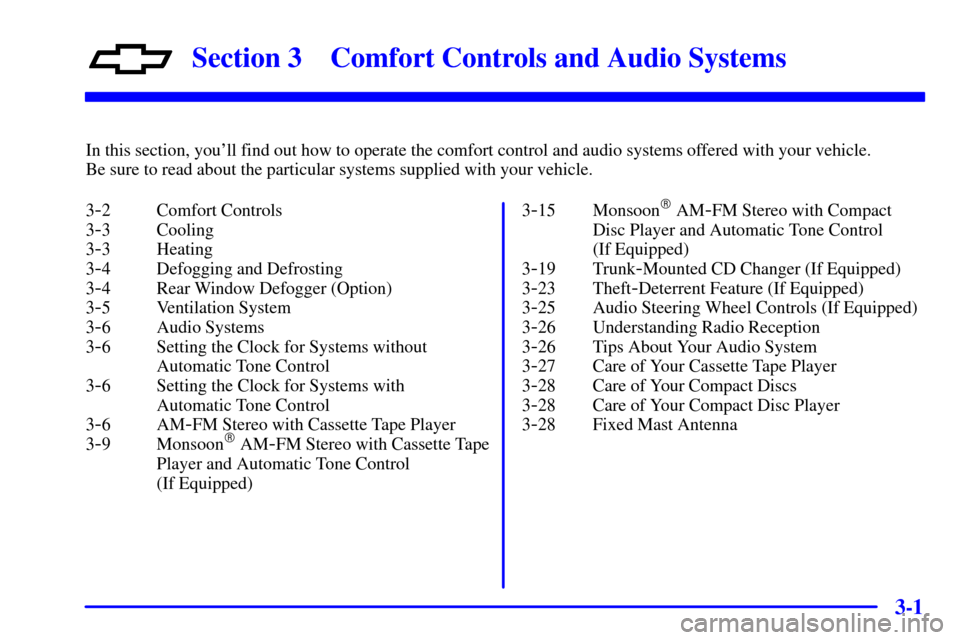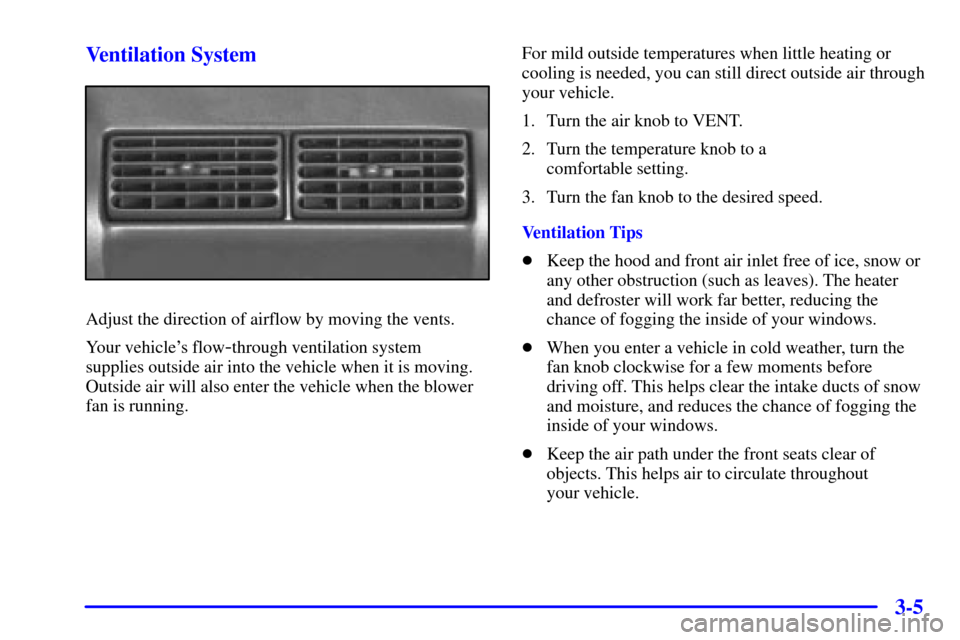Page 5 of 363
Table of Contents (cont'd)
Defensive Driving
Drunken Driving
Control of a Vehicle
Braking
SteeringDriving Tips for Various Road Conditions
Recreational Vehicle Towing
Loading Your Vehicle
Towing a Trailer Heating and Air Conditioning
Setting the Radio Clock
Radio/Cassette Player/CD PlayerRadio Theft-Deterrent Feature
Steering Wheel Controls (If Equipped)
Hazard Warning Flashers
Jump Starting
Towing Your VehicleEngine Overheating
Changing a Flat Tire
If You're Stuck
Problems on the Road
iii
Section
3
Section
4
Section
5
Comfort Controls and Audio Systems
Your Driving and the Road
Page 76 of 363

2-18
When your vehicle is new, there will be a label covering
the adjustment knob. Remove the label and adjust the
sensor as desired. Turn the knob clockwise to increase
sensitivity and counterclockwise to decrease sensitivity.
The shock sensor is ignored by the alarm system when
the following happens:
�The ignition is on,
�the hatch is open,
�the alarm is disarmed,
�when customized to be ignored, and
�for five seconds after the horn sounds an alarm
or chirp.
The shock sensor is ignored after triggering three full
alarms until the system is rearmed.Remote Keyless Entry Transmitter Locking
If all the doors are closed, locking the vehicle with the
remote keyless entry transmitter will immediately arm
the system. The horn will chirp twice and the parking
lamps will flash, confirming that the system is armed.
If any door is open when the LOCK button is pressed,
the system goes into an armed wait mode, waiting for
the doors to close. Once they are closed, the system will
arm, the horn will chirp twice and the parking lamps
will flash. If the hatch is open or ajar at the time the
system is arming, the horn will only chirp once.
Power Door Lock Switch Locking
If any door is open when the power door lock switch is
pressed, the system goes into an armed wait mode,
waiting for the doors to close. Once they are closed, the
system will arm and the parking lamps will flash. If both
doors are closed when the power door lock switch is
pressed, the system assumes you are inside the vehicle,
so it will not arm. Locking the doors by using the
manual door locks will not arm the system.
Page 123 of 363
2-65
T-Top Roof Panels (Option)
Removing the T-Top Roof Panels
CAUTION:
Don't try to remove the T-top panel while the
vehicle is moving. Trying to remove a T
-top panel
while the vehicle is moving could cause an
accident. The panel could fall into the vehicle and
cause you to lose control, or it could fly off and
strike another vehicle. You or others could be
injured. Remove the T
-top panel only when the
vehicle is parked.1. The door key unlocks the T-top panels. The lock is
located over each door window. Turn the key
counterclockwise to unlock the panel.
Page 137 of 363
2-79
1. Open the hatch and find the tab located along the
driver's side trim panel.
2. Lift up the tab and turn the valve counterclockwise
to release the hydraulic pressure.
3. Turn the ignition key to LOCK.
You can now raise or lower your top manually. Be sure
to close the valve after installing your top so you can
raise or lower it electrically later.
Page 155 of 363

3-
3-1
Section 3 Comfort Controls and Audio Systems
In this section, you'll find out how to operate the comfort control and audio systems offered with your vehicle.
Be sure to read about the particular systems supplied with your vehicle.
3
-2 Comfort Controls
3
-3 Cooling
3
-3 Heating
3
-4 Defogging and Defrosting
3
-4 Rear Window Defogger (Option)
3
-5 Ventilation System
3
-6 Audio Systems
3
-6 Setting the Clock for Systems without
Automatic Tone Control
3
-6 Setting the Clock for Systems with
Automatic Tone Control
3
-6AM-FM Stereo with Cassette Tape Player
3
-9 Monsoon� AM-FM Stereo with Cassette Tape
Player and Automatic Tone Control
(If Equipped)3
-15 Monsoon� AM-FM Stereo with Compact
Disc Player and Automatic Tone Control
(If Equipped)
3
-19 Trunk-Mounted CD Changer (If Equipped)
3
-23 Theft-Deterrent Feature (If Equipped)
3
-25 Audio Steering Wheel Controls (If Equipped)
3
-26 Understanding Radio Reception
3
-26 Tips About Your Audio System
3
-27 Care of Your Cassette Tape Player
3
-28 Care of Your Compact Discs
3
-28 Care of Your Compact Disc Player
3
-28 Fixed Mast Antenna
Page 156 of 363

3-2
Comfort Controls
With this system you can control the heating, air
conditioning and ventilation in your vehicle.
Your vehicle also has the flow
-through ventilation
system described later in this section.
Fan Knob
: Turn this knob to select the force of air you want.Temperature Knob
Turn the knob to change the temperature of the air flowing
from the system. Turn it toward the red area (clockwise)
for warmer air and toward the blue area (counterclockwise)
for cooler air.
Air Knob
OFF: In this setting the system is off.
MAX: This setting provides maximum cooling for
quick cool
-down on very hot days. It recirculates most
of the air inside your vehicle. If it is used for long
periods of time, the air may become dry. This setting
directs air through the upper air vents.
A/C: Use A/C for normal cooling on hot days.
This setting cools outside air and directs it through the
upper air vents.
The air conditioner compressor operates in MAX, A/C,
BI
-LEVEL, BLEND and DEFROST when the outside
temperature is above freezing. When the air conditioner
is on, you may sometimes notice slight changes in your
vehicle's engine speed and power due to the operation of
the compressor.
Page 159 of 363

3-5 Ventilation System
Adjust the direction of airflow by moving the vents.
Your vehicle's flow
-through ventilation system
supplies outside air into the vehicle when it is moving.
Outside air will also enter the vehicle when the blower
fan is running.For mild outside temperatures when little heating or
cooling is needed, you can still direct outside air through
your vehicle.
1. Turn the air knob to VENT.
2. Turn the temperature knob to a
comfortable setting.
3. Turn the fan knob to the desired speed.
Ventilation Tips
�Keep the hood and front air inlet free of ice, snow or
any other obstruction (such as leaves). The heater
and defroster will work far better, reducing the
chance of fogging the inside of your windows.
�When you enter a vehicle in cold weather, turn the
fan knob clockwise for a few moments before
driving off. This helps clear the intake ducts of snow
and moisture, and reduces the chance of fogging the
inside of your windows.
�Keep the air path under the front seats clear of
objects. This helps air to circulate throughout
your vehicle.
Page 160 of 363

3-6
Audio Systems
Your audio system has been designed to operate easily
and give years of listening pleasure. You will get the
most enjoyment out of it if you acquaint yourself with it
first. Find out what your audio system can do and how
to operate all its controls, to be sure you're getting the
most out of the advanced engineering that went into it.
If you have power door locks, your vehicle has a feature
called Retained Accessory Power (RAP). With RAP,
you can play your audio system even after the ignition is
off. See ªRetained Accessory Powerº in the Index.
Setting the Clock for Systems without
Automatic Tone Control
Press SET. SET will appear on the display for
five seconds. Within five seconds, press and hold the
right arrow on the SEEK button until the correct minute
appears. Press and hold the left arrow on the
SEEK button until the correct hour appears.
Setting the Clock for Systems with
Automatic Tone Control
Press and hold HR until the correct hour appears.
Press and hold MN until the correct minute appears.
AM-FM Stereo with Cassette Tape Player
Playing the Radio
VOLUME: This knob turns the system on and off and
controls the volume. To increase volume and turn the radio
on, turn the knob clockwise. Turn it counterclockwise to
decrease volume and turn the radio off.
RECALL: Display the time with the ignition off by
pressing the RECALL knob. When the radio is playing,
press this button to recall the station frequency.